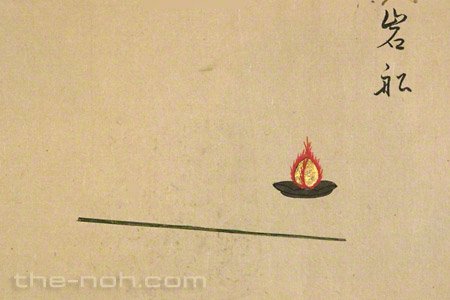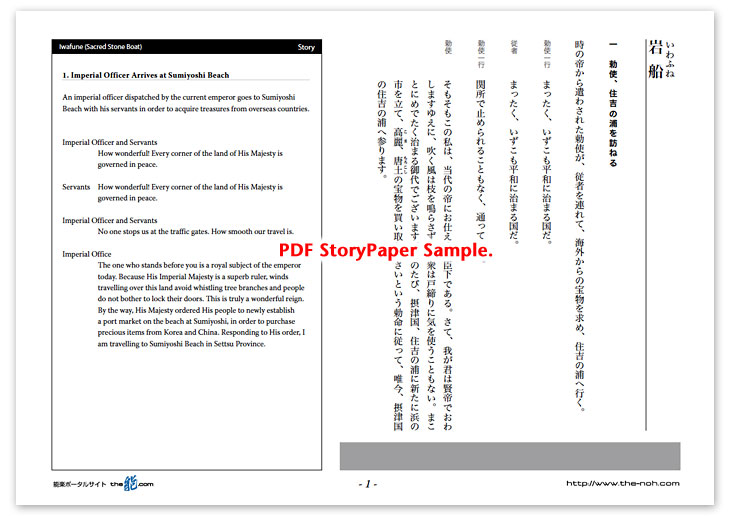
 Iwafune (Sacred Stone Boat)
Iwafune (Sacred Stone Boat)

![]()
Long ago, the emperor ordered his people to newly establish a port market on the beach of Sumiyoshi in Settsu Province (present-day, including Osaka Prefecture), in order to purchase precious items from Korea and China. Responding to His Majesty’s order, an imperial officer is dispatched to Sumiyoshi where he meets a child in Chinese attire who speaks Japanese. The child tells the officer that it came to Japan to laud the reign of His Majesty and offers a jewel on a silver plate as a gift to the emperor. The child then describes the bustle of the seaside market in Sumiyoshi. After enjoying the surrounding scenery, the child informs the officer that the Sacred Stone Boat (the holy boat from Heaven), filled with gifts for the emperor, at that very moment is bound for Sumiyoshi Beach. When the astounded officer asks, the child reveals that it is an incarnation of Amano-sagume, a rower of the Sacred Stone Boat. The child then disappears in a stormy wind.
Soon a dragon deity appears from the deep sea. It announces that it respects deities and has become the guardian of the emperor. It also reveals that it is responsible for protecting the Sacred Stone Boat, and it depicts how the boat arrives at Sumiyoshi Beach. Cooperating with Amano-sagume, as well as getting the support from Eight Great Dragon Kings, the dragon deity pulls the boat toward the shore, keeping time with the pounding of the waves and using the power of ripples and winds. The boat successfully comes ashore on Sumiyoshi Beach. A huge amount of gold, silver and jewels are unloaded. Thanks to the protection given by the deities, the reign of His Majesty flourishes forever.
![]()
This is an auspicious Noh piece filled with a celebratory atmosphere, which gives the audience a refreshed feeling. It does not leave one feeling serious or heavy but rather it is airy, short, and straightforward.
The setting of the treasures gathered from Korea and China makes this piece unique. It intimates how Japan traded internationally and communicated with foreign counties in the ancient times. You might become interested in the mae-shite, the child who speaks Japanese but wears Chinese attire. In Noh dramas, most of the roles of children are likely to be an incarnation of a ghost, spirit, or something belonging to another world. Similarly, the child in this piece is the incarnation of Amano-sagume, who descends from Heaven. This also indicates that the people at that time recognized that international trade had some connection with the supernatural powers of Heaven. Their worldview, which is different from our physical and direct modern view, might invite the audience to enjoy the difference as well as give it some special consideration.
The exoticism of the international port at ancient Sumiyoshi Beach, the Sacred Stone boat approaching the shore, and the treasures from Heaven filling the boat all make this piece even more amusing, especially if you activate your imagination regarding these exotic things.
In the Kanze school, this is performed as a sheer celebratory piece played in han-noh style, which cuts most of the scenes in maeba.
STORY PAPER : Iwafune (Sacred Stone Boat)
Story Paper presents noh chant stories in modern speech, with story outlines, highlights and more using Adobe PDF format, which can print out and zoom in. Print out the pages and take them with you when you see the actual noh performance.

The copyright of Story Paper is held by the Noh.com. Story Paper is for individual use only. It is prohibited by the copyright law to distribute or publish printed-out Story Paper pages without prior consent. For more information, check the credit and disclaimer pages.



 [Iwafune (Sacred Stone Boat) : Story Paper PDF : 590KB
[Iwafune (Sacred Stone Boat) : Story Paper PDF : 590KB